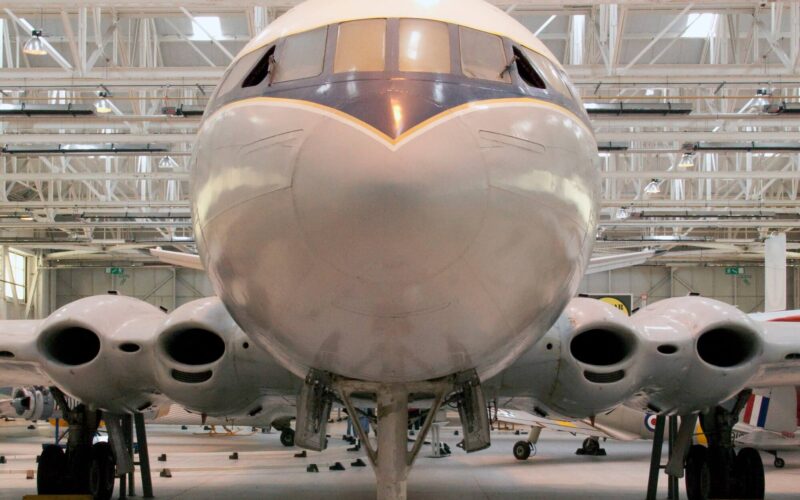On July 27, 1949, the de Havilland Comet prototype flew for the first time, taking to the sky from Hatfield Aerodrome in Hertfordshire, UK.
The Comet was the world’s first pressurized commercial jet airliner, offering a heightened level of comfort and promising a new era for aviation as well as Britain’s future within the aircraft manufacturing sector.
The story of the Comet is one of triumph and tragedy. While it remains one of the most iconic aircraft ever to grace the skies, and propelled advancement within the industry, there is also a story of great loss and design flaws. Nevertheless, various investigations helped aviation to understand concepts such as pressurization and metal fatigue thereby shaping the future of aircraft design.
Brabazon Committee
In March 1943, the British Government set up the Brabazon Committee to plan for the country’s commercial aircraft requirements in a post-war era.
The committee defined several types of aircraft, with varying specifications, one being the Type IV which was envisioned as a jet-powered, high-speed aircraft capable of flying non-stop transatlantic and carrying a generous payload.
Sir Geoffrey de Havilland, who was on the committee, championed the idea of a commercial jet and, by 1945, the de Havilland company had been awarded the contract. This new jetliner was given the title DH.106 and would go on to be styled as ‘The Comet’.
Design
The specifications of DH.106 were so advanced that de Havilland had to design and develop the airframe and the engines from scratch. The man tasked with this was Ronald Eric Bishop, who had previously designed the famous de Havilland Mosquito combat aircraft.
The Comet showcased unique design features including swept wings in which the engines were embedded, creating a streamlined, low-drag profile. With a cruising altitude of 42,000ft, it flew around twice as high and twice as fast as its propeller-driven rivals.
On board, luxury included large windows, table seating and a galley capable of serving both hot and cold food as well as separate men’s and women’s toilets. The absence of propeller engines along with a pressurized cabin made for a quieter and smoother journey for passengers.
In 1951, BOAC, who had ordered 10 of the Comets, made its first commercial flight. During its first year, the Comet carried more than 30,000 passengers including HM Queen Elizabeth II, the Queen Mother and Princess Margaret. BOAC scheduled flights to Tokyo, Singapore and Johannesburg, with flight times cut by over half compared to other aircraft operators.
The ability to fly at high altitudes was increasingly seen as advantageous and the way forward for commercial aviation. The Comet for example, could fly above bad weather while other aircraft with lower cruising altitudes had to divert or delay flights.
Comet disasters
The newfound success of the de Havilland Comet did not last long. On January 10, 1954, 20 minutes after takeoff, BOAC flight 781 crashed into the Mediterranean killing all 35 on board.
Less than three months later, in April 1954, South African Airways Flight 201 crashed in similar circumstances with the loss of all 21 passengers and crew.
The Royal Navy was tasked with salvaging the wreckage and an investigation was launched. With no eyewitnesses and a lack of evidence, the Comet was grounded and the production line at Hatfield was halted.
In the subsequent inquiry, groundbreaking extensive research and testing was carried out. Naval teams salvaged the BOAC aircraft and it was partially reconstructed at Farnborough, England for analysis.
The investigators found significant stress points in the fuselage skin, particularly at the corners of the windows, which were famously square on the Comet.
In an attempt to further understand pressure, stress and fatigue, investigators submerged a life-size Comet in a purpose-built water tank. The aircraft was subject to pressure cycles and, during one of these cycles, the fuselage ripped open.
The investigation determined that the tragic accidents were attributed to metal fatigue as a result of repeated pressurization cycles, leading to a structural failure.
The de Havilland company redesigned the aircraft, strengthening the fuselage skin and replacing the square windows with the oval windows we are all familiar with today, the curvature of which eliminates any stress concentration.
Legacy
The lessons learned from the Comet were heeded by manufacturers including Boeing and Douglas. The industry moved to ‘fail-safe’ designs, which incorporate redundancies and multiple path-loads, meaning that in the failure of a safety critical component or structure, the load is carried by an alternate duplicated component.
Unfortunately, despite the redesigned and improved Comet 3 and 4 aircraft, sales never recovered, and with the arrival of the Boeing 707 and Douglas DC-8 on the market, airlines turned to these larger, more efficient aircraft.
In total, 114 Comet aircraft were built, with operators including Dan-Air, BOAC, BEA and the RAF. The final commercial flight of the Comet was in November 1980, with operator Dan-Air.
Today there are Comet aircraft on display at RAF Museum Cosford and the Imperial War Museum Duxford as well as at the Flugausstellung Peter Junior museum in Germany.

